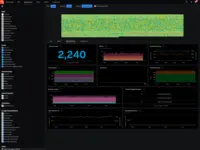Starting at $15 per month
View PricingOverview
What is Splunk Infrastructure Monitoring?
SignalFX is Real-Time Cloud Monitoring and Observability for Infrastructure, Microservices and Applications. SignalFX was acquired by Splunk in August 2019. SignalFX Infrastructure Monitoring provides real-time cloud monitoring and observability platform for infrastructure, microservices and DevOps. A new SignalFX product, SignalFx…
Recent Reviews
Awards
Products that are considered exceptional by their customers based on a variety of criteria win TrustRadius awards. Learn more about the types of TrustRadius awards to make the best purchase decision. More about TrustRadius Awards
Reviewer Pros & Cons
Pricing
Entry-level set up fee?
- No setup fee
For the latest information on pricing, visithttps://www.splunk.com/en_us/products/p…
Offerings
- Free Trial
- Free/Freemium Version
- Premium Consulting/Integration Services
Starting price (does not include set up fee)
- $15 per month
Product Details
- About
- Integrations
- Competitors
- Tech Details
- Downloadables
- FAQs
What is Splunk Infrastructure Monitoring?
Splunk Infrastructure Monitoring aims to enable faster innovation, operational agility, and better customer experience through real-time AI-driven streaming analytics allowing accurate alerts in seconds. Splunk Infrastructure Monitoring is designed to shorten MTTD and MTTR by providing real-time visibility into cloud infrastructure and services. These benefits are built on Open-Source frameworks, eliminating vendor lock-in and built for cloud-native enterprise scale to support even the largest of environments.
Splunk Infrastructure Monitoring Screenshots
Splunk Infrastructure Monitoring Integrations
- Amazon Web Services
- Kubernetes
- Amazon Elastic Container Service (Amazon ECS)
- Amazon DynamoDB
- Microsoft Azure
- Google Kubernetes Engine
- Amazon EC2 Auto Scaling
- AWS Lambda
- Apache Kafka
- MongoDB
- Redis™*
- Apache Cassandra
- Envoy Visitors
- NGINX
- HAProxy Community Edition
- Jenkins
- etcd
- Google Cloud Functions
- Terraform
- by HashiCorp
- Consul
- by HashiCorp
- AWS Elastic Load Balancer
- Active MQ
- Istio Service Mesh
- Over 200 other integrations
Splunk Infrastructure Monitoring Competitors
Splunk Infrastructure Monitoring Technical Details
| Deployment Types | Software as a Service (SaaS), Cloud, or Web-Based |
|---|---|
| Operating Systems | Unspecified |
| Mobile Application | Apple iOS |
Splunk Infrastructure Monitoring Downloadables
Frequently Asked Questions
SignalFX is Real-Time Cloud Monitoring and Observability for Infrastructure, Microservices and Applications. SignalFX was acquired by Splunk in August 2019. SignalFX Infrastructure Monitoring provides real-time cloud monitoring and observability platform for infrastructure, microservices and DevOps. A new SignalFX product, SignalFx Microservices APM, was released March 2020 to detect issues, provide real-time app troubleshooting, and future-proof expectations.
Splunk Infrastructure Monitoring starts at $15.
The most common users of Splunk Infrastructure Monitoring are from Enterprises (1,001+ employees).











